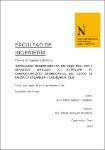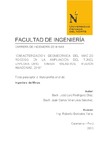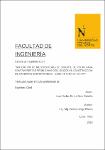Mostrar el registro sencillo del ítem
Estimación geoestadística del RQD, RCU, JRC y densidad aplicada a entender el comportamiento geomecánico del cerro La Falda, La Encañada – Cajamarca, 2019
| dc.contributor.advisor | Vásquez Mendoza, Óscar | |
| dc.contributor.author | Gálvez Caballero, Juan Omar | |
| dc.date.accessioned | 2019-07-05T00:35:39Z | |
| dc.date.available | 2019-07-05T00:35:39Z | |
| dc.date.issued | 2019-06-21 | |
| dc.identifier.citation | Gálvez, J. O. (2019). Estimación geoestadística del RQD, RCU, JRC y densidad aplicada a entender el comportamiento geomecánico del cerro La Falda, La Encañada – Cajamarca, 2019 (Tesis de licenciatura). Repositorio de la Universidad Privada del Norte. Recuperado de http://hdl.handle.net/11537/21807 | es_PE |
| dc.identifier.other | 622 GALV/E 2019 | es_PE |
| dc.identifier.uri | https://hdl.handle.net/11537/21807 | |
| dc.description.abstract | En la actualidad existen diversos métodos geotécnicos y clásicos que permiten estimar, diseñar y evaluar los macizos rocosos. En la presente investigación aplicare técnicas geoestadísticas como el método de Kriging, análisis de tendencia de datos (Trend Analysis) procedimientos de análisis de la normalidad de datos, variogramas, estadística univariada y bivariada para analizar el macizo rocoso del cerro la Falda- La Encañada, Cajamarca. Se analizaron cuatro tipos de parámetros: RQD (%): “Designación de la calidad de la roca”, este parámetro nos brindará el resultado de tipo de calidad de roca que existe en la zona, el cual fue medido a partir de la ocurrencia de fracturas por metro lineal. RCU: “Resistencia a la compresión uniaxial, se obtuvo a partir de la medición del rebote obtenido del martillo de SCHMIDT y se trabajó en base a un ábaco (Miller, 1996) este parámetro nos proporcionará la resistencia del macizo rocoso. JRC: “Coeficiente de rugosidad de las juntas, este parámetro nos dará el tipo de rugosidad presente en el macizo rocoso, los resultados se obtuvieron con el peine de BARTON. Densidad: Se obtendrá a partir de los análisis realizados a las muestras obtenidas en campo. Al obtener estos parámetros y analizar las muestras obtenidas de todos los puntos de muestreo en campo, se determinó cual es el comportamiento del macizo rocoso mediante la estimación geoestadística, en la cual se incluye técnicas de reducción del error y consideraciones previas de hipótesis intrínseca e hipótesis estacionaria. PALABRAS CLAVE: Designación de la calidad de la roca (RQD), Resistencia a la compresión uniaxial (RCU), Coeficiente de rugosidad de las juntas (JRC), densidad, técnicas geoestadísticas. | es_PE |
| dc.description.abstract | At present there are various geotechnical and classical methods that for estimating, design and assess rock mass. In the present investigation, I will apply geostatistical techniques as the method of Kriging, trend analysis data (Trend Analysis), analysis procedures normality of the data, variograms, univariate and bivariate statistics to analyze the rock mass of La Falda-La Encañada, Cajamarca Four types of parameters were analyzed: RQD (%): "Designation of the quality of the rock", this parameter will give us the result of type of rock quality that exists in the area, which was measured from the occurrence of fractures per linear meter. RCU: "Resistance to uniaxial compression, was obtained from the measurement of the rebound obtained from the hammer of SCHMIDT and worked on the basis of an abacus (Miller, 1996) this parameter will provide us with the strength of the rock mass. JRC: "Coefficient of roughness of the joints, this parameter will give us the type of roughness present in the rock mass, the results were obtained with the comb BARTON. Density: It will be obtained from the analyzes made to the samples obtained in the field. When obtaining these parameters and analyzing the samples obtained from all the sampling points in the field, the behavior of the rock mass was determined by means of geostatistical estimation, which includes error reduction techniques and previous considerations of intrinsic hypothesis and hypothesis. stationary | es_PE |
| dc.description.uri | Tesis | es_PE |
| dc.format | application/pdf | es_PE |
| dc.format | application/msword | es_PE |
| dc.language.iso | spa | es_PE |
| dc.publisher | Universidad Privada del Norte | es_PE |
| dc.rights | info:eu-repo/semantics/openAccess | es_PE |
| dc.rights | Atribución-NoComercial-CompartirIgual 2.5 Perú | es_PE |
| dc.rights.uri | https://creativecommons.org/licenses/by-nc-sa/2.5/pe/ | * |
| dc.source | Universidad Privada del Norte | es_PE |
| dc.source | Repositorio Institucional - UPN | es_PE |
| dc.subject | Resistencia a la compresión | es_PE |
| dc.subject | Ingeniería de minas | es_PE |
| dc.subject | Minería | es_PE |
| dc.subject | Mecánica de suelos y rocas | |
| dc.subject | Estudios de suelos | |
| dc.title | Estimación geoestadística del RQD, RCU, JRC y densidad aplicada a entender el comportamiento geomecánico del cerro La Falda, La Encañada – Cajamarca, 2019 | es_PE |
| dc.type | info:eu-repo/semantics/bachelorThesis | es_PE |
| thesis.degree.grantor | Universidad Privada del Norte. Facultad de Ingeniería | es_PE |
| thesis.degree.level | Título Profesional | es_PE |
| thesis.degree.discipline | Ingeniería de Minas | es_PE |
| thesis.degree.name | Ingeniero de Minas | es_PE |
| dc.publisher.country | PE | es_PE |
| dc.subject.ocde | https://purl.org/pe-repo/ocde/ford#2.07.05 | es_PE |
| thesis.degree.program | Pregrado | es_PE |
| dc.description.sede | Cajamarca | es_PE |
| renati.advisor.dni | 46795074 | |
| renati.advisor.orcid | https://orcid.org/0000-0003-4920-2204 | |
| renati.author.dni | 76935751 | |
| renati.discipline | 724026 | es_PE |
| renati.level | https://purl.org/pe-repo/renati/level#tituloProfesional | es_PE |
| renati.type | https://purl.org/pe-repo/renati/type#tesis | es_PE |
Ficheros en el ítem
Este ítem aparece en la(s) siguiente(s) colección(ones)
-
Tesis [530]








